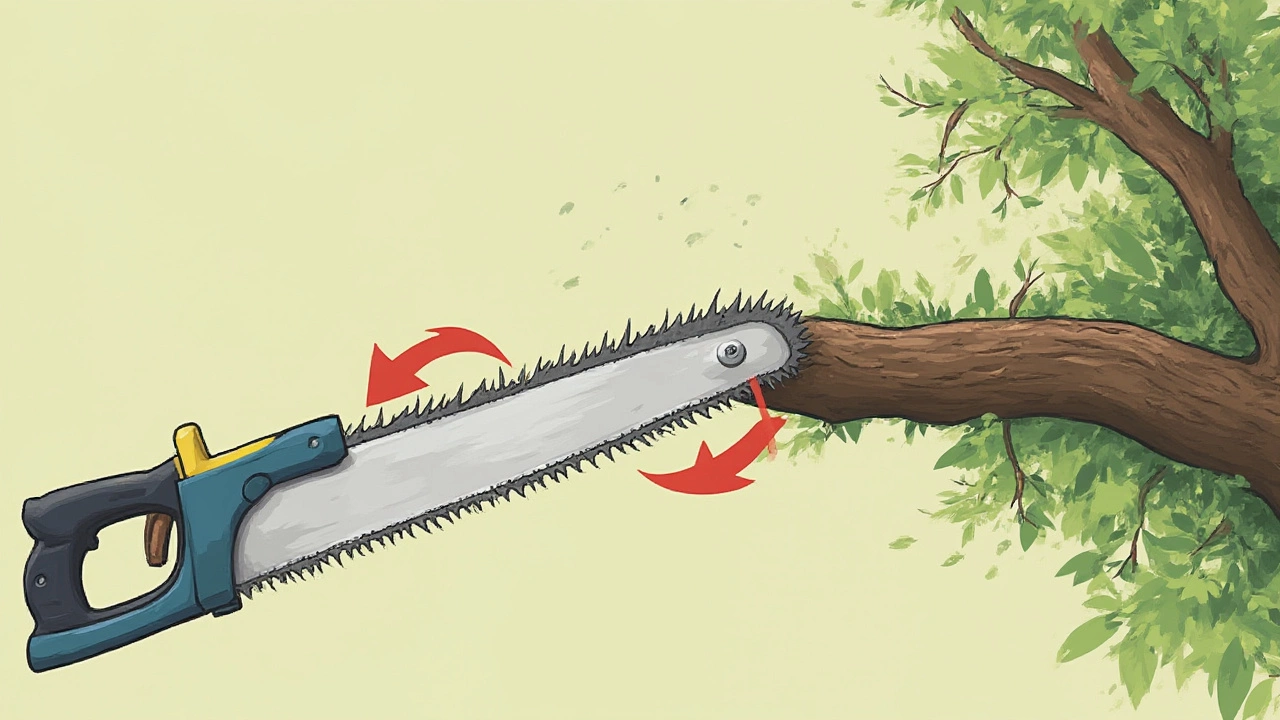If you’ve ever grabbed a pruning saw and fumbled with it while wrangling some stubborn branches, you may have had this moment: Why does it feel so awkward? Maybe the blade is binding, or you’re working way harder than seems logical. Let’s tackle this directly—do pruning saws cut when you push forward or when you pull back? The answer isn’t just trivia; it has a massive impact on your comfort, safety, and results in the garden.
Understanding Pruning Saw Design
Pruning saws aren’t just little hand saws with random teeth sticking out. Every detail of their design, from blade shape to tooth pattern, relates to the type of cut and the trees in a garden. Most pruning saws made for home gardeners use have curved or straight blades with teeth shaped in a very particular way: they are usually angled to bite into the wood as you pull the saw toward yourself. These are called pull-cut saws.
The idea might sound simple—cutting as you pull—but there’s a good reason behind this. When you pull a saw, you naturally have more control over your motion. The blade is less likely to jump out of the cut or bind, which means you’re safer and less likely to accidentally hurt yourself or the tree. Plus, you’re using your stronger muscle groups for the action, and that means the job gets done faster and with less fatigue. Some Japanese saws, for example, are famous for their razor-sharp pull-action teeth, giving a cleaner, more precise cut and less effort per stroke.
Now, not all pruning saws stick to the pull-cut method. You’ll find push-cut saws too, where the teeth are designed to cut on the forward stroke. These are more common in Western-style saws and are useful for particular situations, like cutting larger branches on thick trunk-like wood. However, push-cut saws tend to be stiffer since pushing a thin, flexible blade causes it to bend or buckle, which most gardeners want to avoid.
Let’s clear up one common mistake: just because you own any hand saw doesn’t mean it works for every pruning job. Hardware store saws, carpenter saws, and some hybrid models can cut on both push and pull, but those are rarely ideal for working in cramped branches or above your head. Most pruning saws for trees and shrubs are pull-cut as a safety and efficiency boost.
Here’s a quick tip that can save time: if you’re not sure about your saw, look at the teeth. If they bend backward (toward the handle), the saw is designed to cut on the pull. If they point forward, it’s for push. Some models, called "push-pull saws," actually cut on both strokes, but these are less common in pruning.
Push vs Pull: Why the Difference Matters
This isn’t just some garden geek debate. The difference between push and pull directly affects how your cut turns out—and your pruning day satisfaction! Pull-cut saws, like many Japanese-made tools, are a joy to use on green, sappy branches. Since you apply force as you pull, the blade naturally sits inside the groove it creates, making it hard to skip or slip. That’s perfect when reaching up on a ladder, shaping a fruit tree, or working in someone else’s prized flowerbed where precision matters.
Let’s talk ergonomics for a moment. Pulling is less stressful on your arms, shoulders, and even your back. The risk of hurting yourself is way lower, especially for frequent gardeners or those who already have old shoulder injuries nagging at them. For example, a 2023 study by the University of Tokyo found that gardeners using pull-cut saws reported 30% less muscular fatigue and 45% fewer accidental slips compared to those using push-cut saws for typical yard pruning tasks. Besides, the pulling motion allows for smoother, longer cuts, which makes cleaning up woody branches cleaner and reduces rough edges that can invite pests or diseases.
Push-cut saws, by contrast, have their place in the workshop or for cutting dry, dense wood. But think about the average garden job: it’s often awkward, above your head, and surrounded by twigs or leaves. Try pushing a blade with force in that scenario, and you might find the blade bending or even jumping out of the cut, which can damage living tissue or nick your favorite apple tree. Push strokes are also more tiring if you need to repeat them dozens or hundreds of times in a day.
Pull-cut teeth are typically smaller and sharper, which is why the cut they leave behind is almost always finer than what a push-cut saw can do. That means healthier healing for your trees or shrubs and less chance for fungi or pests to move in. On the flip side, if you have thick, gnarly old wood—like ancient lilacs or a stubborn maple limb—a push-cut saw backed by a strong, rigid frame can help blast through those tough spots more easily.
If you ever get stuck on which saw to use, ask yourself: am I cutting green, softwood above ground, or large, dry, heavy stuff? For 80% of day-to-day branch work, the pull-cut pruning saw wins hands down for both speed and clean results.

Choosing the Right Pruning Saw for Your Job
Browsing the tool aisle or shopping online can get overwhelming—there are hundreds of pruning saws, each promising the perfect cut. Don’t get lost in the claims. Picking the right saw is about matching tooth pattern, blade shape, and saw length to the job at hand. For most gardeners, a curved, pull-cut pruning saw between 10 to 15 inches is a true workhorse. That covers fruit trees, small ornamental shrubs, and most stuff you’ll find in an average backyard.
Curved blades naturally glide into branches at awkward angles, so they’re awesome for overhead work or stuff deep inside dense growth. Straight blades are better for controlled cuts on open, accessible branches. Just remember, it’s much easier to cut something with a blade designed for that specific action. Pull-cut saws dominate here, especially with impulse-hardened or tri-edge teeth, which stay sharp for years of furious pruning. Look for popular brands such as Silky, ARS, or Corona. These saws have teeth arranged so each pull strokes actually files and slices through hard wood rather than ripping it apart, which makes pruning way less of a slog.
If you want a saw for heavy-duty stuff, check out push-cut bow saws or Western handsaws made with thick, rigid blades. But be sure that they can fit between branches and aren’t too heavy for long sessions. Hybrid models, sometimes labeled as dual-action, give you teeth angled for both push and pull. They can work if you like variety, but they’re a jack-of-all-trades tool, not a master for tough pruning tasks. Realistically, most people never need these unless they split their outdoor time between woodworking and gardening.
Testing grip comfort is underrated—hold the saw as if you’re actually reaching up or bending over to reach a branch. Does your hand cramp? Is the handle rubberized or textured so sweaty hands won’t slip? And can the blade be replaced or resharpened easily? These are details nobody loves to research, but getting them right saves headaches down the road.
On maintenance: a saw that’s easy to clean and oil is a friend worth keeping for years. After each pruning session, give your blade a quick scrub with a wire brush and a squirt of penetrating oil. Not only does this keep the teeth sharper, but it also prevents sap buildup and rust. Table 1 below summarizes types of pruning saws, their main design trait, and their best uses.
| Type | Blade Shape | Cut Action | Best Use |
|---|---|---|---|
| Traditional Pull-Cut | Curved/Straight | Pull | Green branches, precise cuts |
| Push-Cut | Straight | Push | Dry, hard wood; large limbs |
| Duel Action | Straight | Push & Pull | General DIY, non-specialist work |
Expert Tips for Getting the Best Pruning Results
So you’ve picked your pruning saw, you know whether it’s push or pull—what’s next if you want those pro-level, satisfying cuts? The biggest secret is to let the saw’s teeth do the work. People often saw too aggressively, pushing down or yanking wildly, which risks splitting the branch, wrecking the saw, or wearing themselves out. Instead, start slow. Use your first strokes just to create a shallow notch; this helps your saw bite in the right spot and stops it from jumping.
When using a pull-cut saw, hold the branch steady with your non-dominant hand. Place the saw teeth right where you want the cut. Pull the saw back smoothly and steadily; don’t rush. The sharper the blade, the less you need to push down. For thicker branches, consider making an undercut—saw a notch partway from underneath, then cut through from the top. This stops the bark from tearing and keeps wounds clean. The cleaner the cut, the easier it is for your tree to heal and fight off infections.
If you’re slicing bigger limbs, or working high up, keep your stance balanced and braced. If you ever find yourself sawing overhead or up a ladder, take it slow. Fatigue and awkward postures are the #1 causes of pruning accidents, not blunt blades!
Proper storage matters too. Don’t just toss your saw into a toolbox. Clean the blade, oil it, and store it in its sheath or a dry spot away from moisture. Good saws stay sharp for years with basic care. Replace blades when they start to feel dull or too much sap has caked on the teeth and cleaning isn’t helping.
A quick bonus trick: If your saw blade ever starts sticking in green wood, rub a bit of candle wax or bar soap along the teeth. It helps the blade slip through sappy branches without binding.
Finally, match the saw to the size of branch. For twigs under a finger’s width, use secateurs or loppers—your saw will only tear them. Save the saw for branches thicker than a pencil. For monster limbs, a pruning chainsaw or large bow saw may be the better fit. And always work with eye protection, and wear gloves when dealing with spiky branches or dense undergrowth. This way you spend more time admiring your handy work than plucking splinters from your hands—or worse.
Nail these simple techniques and you’ll soon be slicing effortlessly, leaving behind healthy trees and shrubs that bounce back fast. Knowing exactly when and why to use a pruning saw—and whether to push or pull—will turn the most ordinary garden tasks into a day of confident, satisfying progress. You won’t just see the difference. You’ll feel it, every time you reach for that trusty saw.
